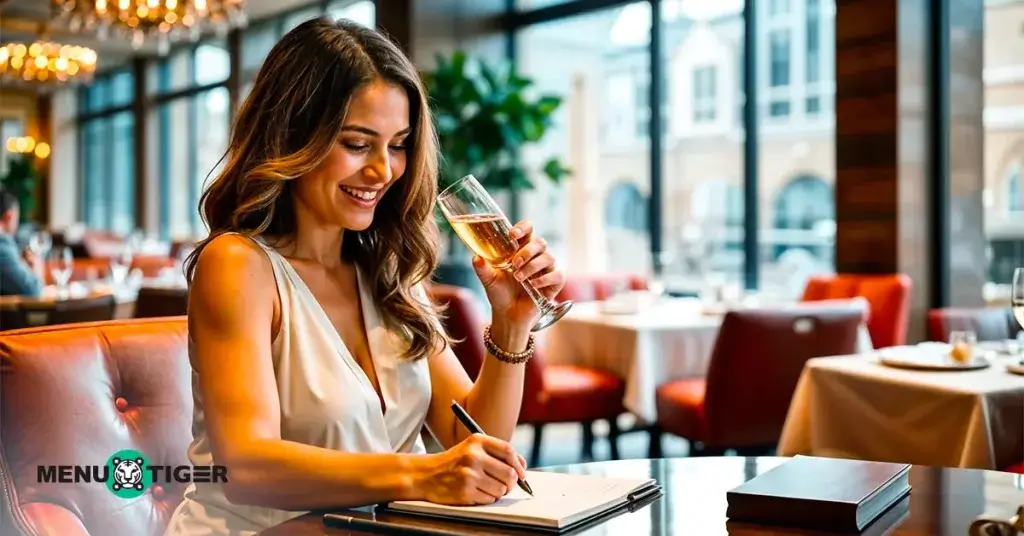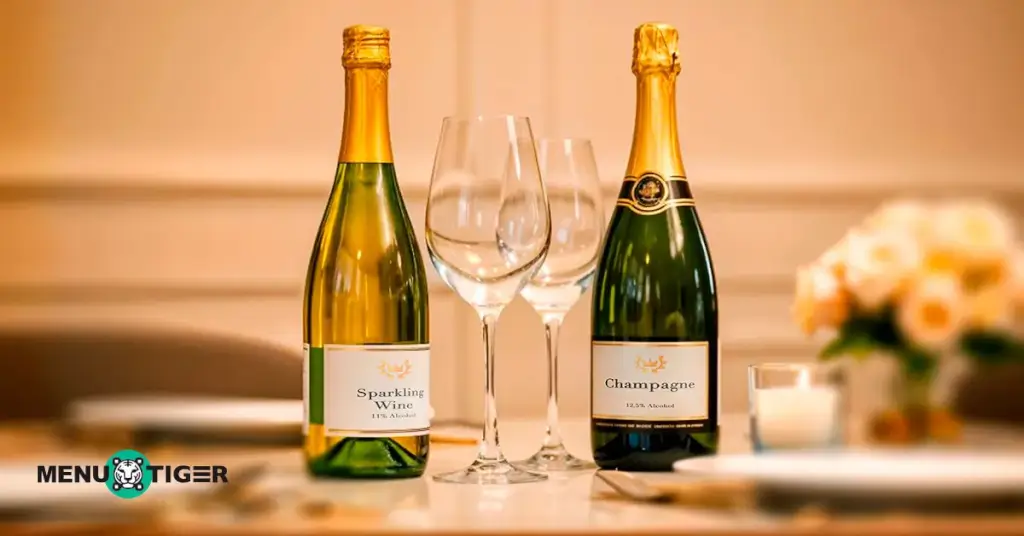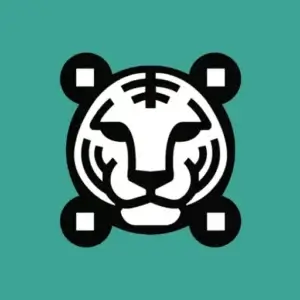When choosing between sparkling wine vs. Champagne, it is best you understand their key differences to curate the perfect experience for your guests.
Though both offer enticing bubbles, remember they cater to different preferences.
This comprehensive guide discusses key points such as where they’re made from, the wine method used, the aging period, and even their pricing to help you tailor recommendations, ensuring that everyone finds the perfect bubble to suit their mood and occasion.
To add to the guest experience, a modern touch of presenting them through QR code menus or any digital tools you have is a win-win feat: A satisfied customer with advanced customer service and a cost-saving tool for promotions.
Sparkling wine vs Champagne: Is there a difference?
A refreshing glass of bubbles hits the spot perfectly, especially on celebratory nights or cozy, silent occasions.
But, not all bubbles are deemed to be equal or the same.
Yes, though champagne and sparkling wine give off this ‘bubbly’ appearance when poured, there seemed to be something yet to be told.
The Hamper Emporium — an Australian-operated family business specializing in creating luxurious gift hampers, pointed out that Champagne is indeed a sparkling wine, but not all sparkling wine is Champagne.
Let’s dig a little deeper and find out the distinctions between the two.
7 important points to remember in differentiating champagne and sparkling wine

Knowing the nitty-gritty of your wines serves you with valuable insights when brainstorming your food and drink pairing ideas and other wine-related menus.
So, if you’re adding champagne or any sparkling wine (or both) on the line, here’s a list of helpful information you can use in choosing what’s best for you:
Region: Where did it come from?
“But, why isn’t all sparkling wine Champagne?” you may ask.
The first distinction you should keep in mind is the region.
Champagne wine is strictly produced in the Champagne region of France (Northeast, to be exact) under specific regulations that govern everything from the vineyards to the winemaking process.
This then makes it a regional identity that grants the label a certain prestige and exclusivity.
In contrast, sparkling wine is the broader term for any bubbly wine made outside of Champagne.
This means that any sparkling wine made outside the Champagne region should not be called ‘Champagne’ but the former.
Method: How are they made?

Another key difference you must know is the method used in producing these wines.
Champagne is strictly made using the traditional method or méthode champenoise, where the fermentation happens inside the bottle, creating bubbles when poured.
This method is particularly labor-intensive and involves lengthy procedures of riddling, disgorging, and aging.
Sparkling wines like Cava use the same method. However, some, like Prosecco wine, use the Charmat Method, where the secondary fermentation happens in large tanks.
This fermentation approach is faster than doing it in a bottle, which results in a different type of bubbling — larger and less persistent than the ones you find in a glass of champagne.
Grapes: What grape variety is used?

The kind of grapes used is also an indicator of distinguishing these two.
Champagne is made from three grape varieties: Pinot Noir, Chardonnay, and Pinot Meunier.
The blend of these grapes, along with the cool climate of Champagne, creates the signature acidity and finesse of the wines.
Sparkling wines, on the other hand, are made from a variety of grapes depending on the region. Prosecco sparkling wine from Italy uses the Glera grape, which gives off a light, fresh character.
Also, Cava in Spain is made from native grapes like Xarel-lo, Parellada, and Macabeo, which contribute a distinct flavor profile.
Price: How much does each cost?
In terms of price, Champagne is relatively expensive compared to other sparkling wines.
The delicate, tedious, and long process influences the rate, but the high demand for the label “Champagne” makes it more luxurious and high-end.
ABC News reported a bottle of Brut Champagne Dom Perignon Plenitude is worth more than $300.
And according to FinanceBuzz’s latest projections, Americans expect to pay an average of $57.94 a bottle this year, an increase of $2.09 from last year.
Other states like New Mexico, Alaska, Arkansas, and Nebraska would cost around $70.
Sparkling wines, however, offer a range of prices, from everyday affordability down to luxurious options. For the on-the-budget, a bottle ranges from $10 to $ 25, and for the mid-range class, you get it for around $25 to $50.
These make them more accessible, especially on casual occasions.
Taste: What is the flavor profile?
Champagne and sparkling wine taste profiles are totally different, considering the fermentation process and ingredients used.
Because Champagne ages for a longer period, it imparts toasty, brioche, and nutty notes, while the bubbles created from the fermentation inside the bottle tend to be finer and consistent.
Sparkling wines like Crémant have a lighter, more fruity profile with flavors of green apple, pear, or citrus.
It’s also important to take note that the style of sparkling wine varies depending on the region and method used, but generally, it has this fresher and more approachable taste that non-wine drinkers would enjoy.
Aging period: How long is the reduction of aging?
Another aspect that you should consider is aging.
As required by law, Champagne must mature in the winemakers’ cellars for at least 15 months for non-vintage and at least 36 months for vintage before being released.
But, in practice, it reaches two to three years for the former and 10 years for the latter.
Sparkling wines can also have shorter or longer aging periods. This is determined by the style and regulation of the place where they are produced.
Moscato d’Asti, one of the most celebrated sparkling wines in Italy, is capable of aging for a decade or more. Some would require less than 20 months.
Expert’s note: In addition to local regulation for the timeframe, the aging period depends on the method used by the winemakers. Wines that have undergone the traditional method tend to have a longer aging period since they are kept in bottles, which has a slower progression in maturing.
Food pairing: What food pairs perfectly for each wine?
Food and wine pairing is a delicate matching process that determines if your offering is a hit or a miss.
So, If you’re planning to do a combo menu, either with champagne or sparkling wines, it is best to know what works well with them.
Champagne’s complexity in its flavor profile pairs beautifully with rich, savory dishes, such as oysters, lobsters, fried chicken, or triple cream cheeses.
The acidity and fine bubbles cut through the richness of the food, creating a balanced and enjoyable dining experience.
Sparkling wines with lighter, fruitier flavor profiles can be paired with lighter fare such as antipasti, fruity desserts, or brunch dishes.
Remember that each wine has its own strengths when paired with food. Knowing your wine well can help you make versatile food combo choices.

How to serve both in your bar or restaurant using an interactive restaurant menu QR code software

Introducing new items in your bar requires meticulousness in every detail possible to ensure a positive return.
Before launching a product, you should have a plan for maximizing it, be it sparkling wine, Champagne, or any other type of wine.
One effective way to do that is by leveraging restaurant technology designed to assist you in running your entire business effectively with an assured return on investment.
MENU TIGER, a smart menu restaurant partner, is equipped enough to provide you with the necessary digital tools not only to help promote your offerings but also to build an automated workflow system for better operations and services.
Here’s a rundown of some of its services and features:
Simplified performance metrics display
MENU TIGER QR code menu software offers a comprehensive look at your performance metrics, from the number of orders revenue to the most sold items.
This allows you to monitor the performance of your drinks and other menu items so you’ll be able to align your marketing strategies based on data.
Advanced marketing tools
MENU TIGER offers various restaurant marketing tools you can use in any way possible.
You can create a customizable website to input all the information your customers need.
Say you want Champagne as your brand bearer, you can highlight it prominently for better visibility with its highly customization functions.
Another good thing about this smart menu is you can intuitively add your discounts, special deals, and promos to your website easily.
This is essential, especially if you’re still trying out the products you’re adding to the lineup.
You can also run email marketing effectively as this smart menu software creates an email list of your customers who ordered on your digital menu.
Thus, makes it easier for you to send out your restaurant newsletter and other promotional materials that directly sits on their inbox.
Digital menu access through a QR code menu
Offering sparkling wine or champagne can cost you a big chunk already, and having to reproduce printed menus for your new set of offerings (either a combo or for an add-on) and menu rotations is the last thing you would do.
So, shifting to a digital one that can be accessed using a digital menu QR code can save you from further expenses.
You can add or remove an item easily without any additional pay. Then, with your print or digital QR codes, your customers can access them, place their orders, and pay for them through various payment integrations at their convenience.
Note: To ensure inclusivity among your customers, put out simple instructions on how to scan a menu QR code or train your staff to assist customers to do so.
Automated customer feedback report
Using MENU TIGER’s customer survey service, you can automatically collect feedback in real time.
Using the survey form, you can input your survey questions and deploy them automatically on your website.
Once your digital menu is accessed, your customers can automatically input their feedback without the need for your staff to ask them.
The result will help you decide which of your drink menu needs to be improved or removed from the list, avoiding any further costs in your inventory.
Also you’ll also get profound suggestions and comments about your overall services without pressure from your staff since customers can participate in the survey using their own devices.

Kick off the bubbly showdown using the MENU TIGER QR code menu
Sparkling wine vs Champagne is an ultimate comparison of fizz.
Yet, knowing the bits and pieces of what sets them apart from each other is, in fact, an advantage for a business person like you. But the bottom line lies in how well these two perform.
So, to help you navigate this, MENU TIGER digital restaurant menu QR code software provides advanced and innovative features and solutions designed for a successful showdown of these highly celebrated wines.
With its modern approach, it streamlines the ordering process, creating a more engaging and satisfying experience for your customers — ensuring they’ll keep coming back to your bar or restaurant for their next toast.
So, visit the website, sign up, and get the right sparkle.
FAQs
The prime difference between Champagne and wine lies in their production, region, and characteristics.
Champagne is a sparkling wine made exclusively in the Champagne region of France. It undergoes a two-step fermentation process in the bottle and is made from three grapes: Chardonnay, Pinot Noir, and Pinot Meunier.
In contrast, wine is produced worldwide using various grape varieties, and most wines, like red, white, and rosé, are still without carbonation.
Yes, sparkling wine can pop like Champagne when opened, as both contain carbonation created by a second fermentation process that produces pressure inside the bottle.
However, the intensity of the pop may vary depending on the type of sparkling wine and how much pressure has built up.



